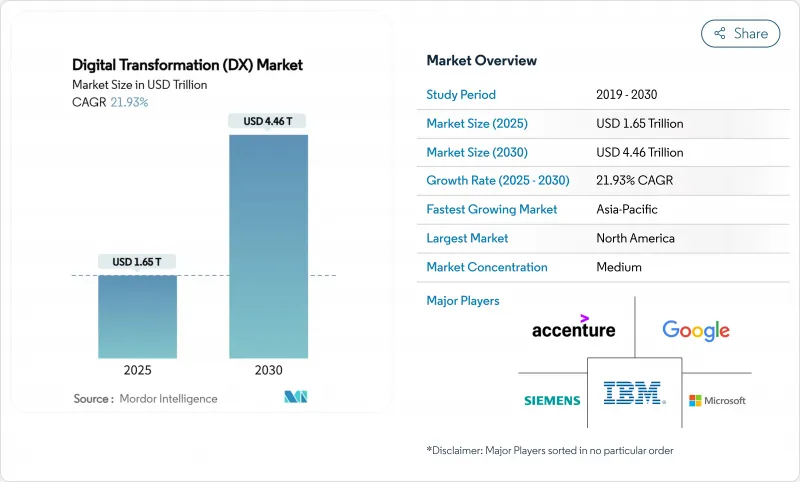
|
市場調査レポート
商品コード
1851589
デジタルトランスフォーメーション(DX):市場シェア分析、業界動向、統計、成長予測(2025年~2030年)Digital Transformation (DX) - Market Share Analysis, Industry Trends & Statistics, Growth Forecasts (2025 - 2030) |
||||||
カスタマイズ可能
適宜更新あり
|
|||||||
| デジタルトランスフォーメーション(DX):市場シェア分析、業界動向、統計、成長予測(2025年~2030年) |
|
出版日: 2025年07月07日
発行: Mordor Intelligence
ページ情報: 英文 135 Pages
納期: 2~3営業日
|
概要
デジタルトランスフォーメーション市場は、2025年に1兆6,500億米ドルと評価され、2030年には4兆4,600億米ドルに達し、CAGR 21.93%で成長すると予測されています。

力強い成長は、企業のAI導入、クラウドファーストの支出優先順位、組織の業務デジタル化を強制する規制の義務化に起因します。ソブリンAI政策は企業にコンピューティングのローカライズを促し、5Gネットワークは製造業やヘルスケアにおけるリアルタイムの使用事例を開拓します。ローコードプラットフォームはIT部門の枠を超えてアプリケーション開発を拡大し、ESG報告ルールはデータ主導のコンプライアンス投資を加速させる。企業がイノベーションの目標とレガシーシステムのコスト圧力とのバランスを取りながら、インクリメンタル・モダナイゼーション戦略が支持されるようになります。企業はロックインを回避するためにマルチベンダークラウドとAI戦略を追求するため、競合の激しさは緩やかなままであるが、ハイパースケールプロバイダの設備投資はデジタルトランスフォーメーション市場におけるスケールエコノミクスを再定義しつつあります。
世界のデジタルトランスフォーメーション(DX)市場の動向と洞察
クラウドファーストの企業IT支出ブーム
企業は、オンプレミスのハードウェアから、AIワークロードやハイブリッドワークモデルをサポートするクラウドネイティブプラットフォームへと予算を再配分しています。例えば、Amazon Web Servicesは、AIアシスタントAmazon Qで100万件以上の社内開発者の質問を解決し、45万時間の手作業を削減しました。クラウドの経済性は、調達サイクルを短縮し、支出を資本予算から運用予算にシフトさせ、より迅速な実験を可能にします。マイクロソフトとコカ・コーラのパートナーシップのような戦略的取引は、ジェネレーティブAIサービスがスケーラブルなクラウド基盤の上に乗ることを示しています。企業がクラウドインフラストラクチャを必要不可欠なものと考える中、ベンダーはソブリン・データ・ルールに準拠するため、各地域のデータセンターを拡張しています。
ビジネス機能全体におけるAI/ML統合の高まり
AIはパイロットから大規模な生産へと移行しています。ゴールドマン・サックスは複数の部門にAIアシスタントを導入し、ユナイテッドヘルス・グループは保険請求や臨床判断を自動化する1,000以上のAI使用事例を管理しています。防衛、産業、小売のリーダーたちは、設計、保守、顧客体験のワークフローに生成モデルを組み込み、このパターンを再現しています。従業員のスキルアップとデータ・ガバナンスのフレームワークが同時に成熟し、AIが実験的な追加機能ではなく、コアコンピテンシーになります。
レガシーな技術的負債の固定化
企業はいまだにIT予算の最大80%を数十年前のシステムの維持に充てており、イノベーションのための資金を削減しています。ServiceNowの調査によると、老朽化したアプリケーションのコストはシステム1台当たり年間4万米ドルで、従業員の労働時間は週17時間です。政府機関は、1,000億米ドル規模のIT支出の大部分をレガシー資産に費やしており、この問題を如実に表しています。その結果生じる技術的負債は、時代遅れのソフトウェアが最新の管理体制を欠いているため、サイバーセキュリティリスクを増大させます。
セグメント分析
AIとMLは、2024年にデジタルトランスフォーメーション市場シェアの27.8%を占め、このセグメントはCAGR 24.5%で成長すると予想され、データ主導の自動化が戦略的差別化要因であることを補強しています。デジタルトランスフォーメーション市場規模のこの部分は、チャットボット、レコメンデーションエンジン、予測メンテナンスモデルを拡張する企業によって促進されています。ゴールドマン・サックスとロッキード・マーティンの実稼働導入は、パイロットからミッションクリティカルなシステムへの移行を象徴しています。拡張現実(XR)ツールは、産業従事者のトレーニング定着率を275%向上させ、ウォルマートの食品トレーサビリティネットワークなどのブロックチェーンソリューションは、原産地確認にかかる時間を7日から2.2秒に短縮しました。
エッジコンピューティングクラスターの並列波は、クラウドレイテンシのペナルティを回避するためにセンサーの近くでデータを処理します。デジタル・ツインと同期した産業用ロボティクスは、自動車工場や電子機器工場での継続的なプロセス最適化を可能にします。アディティブ・マニュファクチャリング(積層造形)ラインでは、金型部品のリアルタイム・プリントを使用してダウンタイムを短縮します。これらの技術を組み合わせることで、重工業全体のデジタルトランスフォーメーション市場への浸透が深まる。
クラウド・ソリューションは2024年にデジタルトランスフォーメーション市場シェアの63.4%を占め、2030年までCAGR 22.8%で拡大します。デジタルトランスフォーメーション市場規模におけるこのシェアは、ハイパースケーラーによる数十億米ドル規模のデータセンター構築と相関しています。AWSのProject Rainierは、Trainium 2チップをクラスター化し、世界で最も強力なAIトレーニング用コンピュータを構築しています。マイクロソフトの800億米ドルのインフラ投資は、投資サイクルのエスカレートを裏付けています。オラクルはグーグル・クラウドと提携し、双方向の低レイテンシリンクをイグジット料金なしで実現しています。
クラウドの経済性は、サーバーのための資本予算がない中小企業にも魅力的です。従量課金モデルはコストと使用量を一致させ、地域のアベイラビリティゾーンはデータ居住規制を満たします。時間の経過とともに、プラットフォームのロックインの懸念から、多くの企業がマイクロサービスを複数のクラウドに分散させるようになり、クロスプレーン・オーケストレーション・ツールの需要を生み出しています。
デジタルトランスフォーメーション市場は、技術別(AIとML、拡張現実(VR/AR)など)、展開モデル別(クラウド、オンプレミス、ハイブリッド)、組織規模別(大企業、中小企業)、業界別(BFSI、ヘルスケアとライフサイエンス、製造業と産業など)、地域別に区分されます。市場予測は金額(米ドル)で提供されます。
地域別分析
北米は2024年にデジタルトランスフォーメーション市場シェアの32.3%を確保し、ベンチャーキャピタルの潤沢な資金とハイパースケールクラウド本社への近接性に支えられました。テキサス州だけで、エヌビディアのスーパーコンピューターを導入した5,000億米ドルのデータセンター拡張が行われ、さらにテキサス・インスツルメンツの300億米ドルのチップ工場が数千人の技術者雇用を増やしています。連邦政府機関や州政府機関は、「ハンフリー」のようなAIアシスタントを採用し、管理業務を自動化することで、需要をさらに押し上げています。USMCAの下での国境を越えた取り組みが、カナダとメキシコ全域での製造業のデジタル化を支援します。
アジア太平洋は、広範な政府インフラ・プログラムとモバイル優先の消費者行動により、CAGR 22.4%と最も速い成長を遂げます。デジタルウォレットはeコマースのチェックアウトの70%近くを占め、この地域の飛躍的な普及曲線を浮き彫りにしています。インド、日本、韓国はそれぞれ国家AI戦略を打ち出しており、オーストラリアのクイーンズランド州はソブリン・クラウド・サービスに12億豪ドル(8億米ドル)を計上しました。こうした動きを合わせると、対応可能なデジタルトランスフォーメーション市場が拡大することになります。
欧州はeIDAS 2.0でデジタル主権を強調し、2027年までに欧州デジタルIDウォレットの普遍的な受け入れを義務付けています。ドイツのEuroStackプログラムでは、2035年までにコンピュートスタックのローカライゼーションのために3,000億ユーロの投資が行われると予測しています。シュレースヴィヒ=ホルシュタイン州では、プロプライエタリ・ソフトウェアからの移行を進めており、主権の理想を実践的に実現しています。南米と中東・アフリカは主要地域の後塵を拝しているが、ファイバー・バックボーン、クラウド地域、5G展開への海外投資が増加しており、新たなサービス機会が生まれています。
その他の特典:
- エクセル形式の市場予測(ME)シート
- 3ヶ月間のアナリストサポート
よくあるご質問
目次
第1章 イントロダクション
- 調査の前提条件と市場の定義
- 調査範囲
第2章 調査手法
第3章 エグゼクティブサマリー
第4章 市場情勢
- 市場概要
- 市場促進要因
- クラウドファーストの企業IT支出ブーム
- ビジネス機能全体にわたるAI/ML統合の高まり
- 5G対応リアルタイムデータの使用事例
- ESG報告書のデジタル化の義務化
- 「デジタル主権」公的資金投入の波
- DXを民主化するローコード/ノーコード・プラットフォーム
- 市場抑制要因
- レガシー・テクニカル・デット・ロックイン
- サイバー人材不足と賃金インフレ
- デジタルアイデンティティ規制の分断
- スコープ-3 ESG監査のためのデータ品質ギャップ
- サプライチェーン分析
- 規制情勢
- テクノロジーの展望
- ポーターのファイブフォース
- 新規参入業者の脅威
- 供給企業の交渉力
- 買い手の交渉力
- 代替品の脅威
- 競争企業間の敵対関係
- エコシステム分析
- 市場のマクロ経済要因の評価
第5章 市場規模と成長予測
- 技術別
- AIとML
- 拡張現実(VR/AR)
- モノのインターネット(IoT)
- 産業用ロボット
- ブロックチェーン
- デジタルツイン
- 積層造形/ 産業用3Dプリンティング
- エッジコンピューティング
- その他
- 展開モデル別
- クラウド
- オンプレミス
- ハイブリッド
- 組織規模別
- 大企業
- 中小企業(SMEs)
- 業界別
- BFSI
- ヘルスケアとライフサイエンス
- 製造業および工業
- 小売とeコマース
- エネルギー・公益事業
- 自動車・運輸
- 政府・公共機関
- その他(メディア、教育など)
- 地域別
- 北米
- 米国
- カナダ
- メキシコ
- 南米
- ブラジル
- アルゼンチン
- その他南米
- 欧州
- ドイツ
- 英国
- フランス
- イタリア
- スペイン
- その他欧州地域
- アジア太平洋地域
- 中国
- 日本
- インド
- 韓国
- 東南アジア
- その他アジア太平洋地域
- 中東・アフリカ
- 中東
- サウジアラビア
- アラブ首長国連邦
- トルコ
- その他中東
- アフリカ
- 南アフリカ
- ナイジェリア
- エジプト
- その他アフリカ
- 北米
第6章 競合情勢
- 市場集中度
- 戦略的動向
- 市場シェア分析
- 企業プロファイル
- Accenture
- Microsoft
- IBM
- Google(Alphabet)
- AWS(Amazon)
- SAP
- Oracle
- Adobe
- Salesforce
- Cisco Systems
- Dell Technologies
- Siemens
- Hewlett Packard Enterprise
- Cognex
- Apple
- ServiceNow
- Infosys
- Capgemini
- Wipro
- Schneider Electric
- Honeywell
- Hitachi
- Fujitsu
- Huawei

